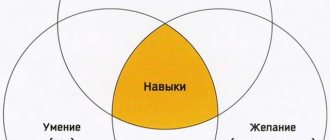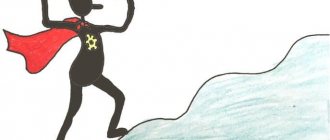A person's individuality is not just a pretty expression. By nature, all people are truly special. These features are embedded in the human psyche, which forms temperament and character.
What are these personality traits that psychologists so often talk about and advise taking into account when choosing a profession and life path? How to use knowledge about the characteristics of temperament and character for good, to achieve success? And how to determine your type of temperament and dominant character traits and, if necessary, correct them? Psychologist-coach Maria Roshchina these questions to the FAN .
photo from the personal archive of Maria Roshchina /
What is temperament and character
Science believes that temperament plays a primary role in the formation of individual personality traits. It is what is called the “biological foundation” on which personality traits are built: stability of emotions, impressionability, energy, adherence to a certain pace of life, reaction to external factors.
Temperament can be considered an innate tendency - it does not change over the course of life. It also determines the characteristics of a person’s behavior and reactions, regardless of what activity he is engaged in.
Among the properties of temperament are:
- reactivity - the degree of a person’s reaction to an external stimulus, be it an event or an offensive word thrown at him;
- activity - energy, which shows how intensely a person strives to influence the outside world;
- plasticity - the ability to adapt to external conditions and obey them;
- rigidity - inertia of behavior in a given situation;
- emotional excitability - the strength of the emotional reaction and the speed of its occurrence.
On the basis of these mental traits, character is built - a system of human characteristics that shows or allows one to predict his actions and behavior in a specific situation. Speaking about character, we mean a set of traits that are most noticeable in a person’s behavior, for example:
- frivolity or thoughtfulness;
- courage or cowardice;
- conscientiousness or lack of seriousness in performing work.
“A person needs character in order to survive in the world and society,” comments psychologist-coach Maria Roshchina. — One of its frequent manifestations is heroism. A person strives to be a hero, and this is natural, since it brings satisfaction. But since there are few opportunities for heroism in everyday life, people tend to create such situations. Examples of this include fashion, television, religion, and supporting your favorite sports team. By joining one of the “trends,” a person can feel like a hero without doing anything heroic.”
4.4. Description of types of accentuations
K. Leongard proposed the following classification of accentuations.
Hyperthymic type.
A noticeable feature of the hyperthymic personality type is the constant or frequent presence in an elevated mood, even in the absence of any external reasons for this. An elevated mood is combined with high activity and a thirst for activity. Hypertims are characterized by sociability and increased talkativeness. They look at life optimistically, without losing this quality even when obstacles arise. Difficulties are often overcome without much difficulty, due to their inherent activity and activity.
12 pages, 5702 words
Personality traits and features of current self-esteem
... distinguished by certain combinations of personality traits and characteristics of self-esteem. The methodological and theoretical prerequisites for the study were the general scientific principles of development, determinism, systematicity, the principle of the unity of consciousness and activity (B.G. Ananyev, A.G. Asmolov, ...
Dysthymic type.
Dysthymic personality is the opposite of hyperthymic personality. Dysthymics tend to focus on the dark, sad aspects of life. This manifests itself in everything: in behavior, in communication, and in the peculiarities of perception of life, events and other people (social-perceptual characteristics).
Usually these people are serious by nature. Activity, and especially hyperactivity, is completely unusual for them.
Cyclothymic type.
The most important feature of the cyclothymic type is the alternation of hyperthymic and dysthymic states. Such changes are frequent and systematic. In the hyperthymic phase of behavior, joyful events evoke in cyclothymes not only joyful emotions, but also a thirst for activity, increased talkativeness, and activity. Sad events cause not only grief, but also depression. This state is characterized by slowness of reactions and thinking, slowdown and decrease in emotional response.
Stuck type.
The stuck personality type is characterized by high stability of affect, duration of emotional response, and experiences. An insult to personal interests and dignity, as a rule, is not forgotten for a long time and is never forgiven just like that. In this regard, others often characterize them as vindictive and vindictive people. There are reasons for this: the experience of affect is often combined with fantasizing, hatching a plan for revenge on the offender. The painful sensitivity of these people, as a rule, is clearly visible. They can also be called sensitive, easily vulnerable, although in combination with the above.
Emotive type.
The main features of an emotive personality are high sensitivity and deep reactions in the field of subtle emotions. Characterized by kindness, kindness, sincerity, emotional responsiveness, and highly developed empathy. All these features, as a rule, are clearly visible and constantly manifest themselves in the external reactions of the individual in various situations. A characteristic feature is increased tearfulness (as they say, “wet eyes”).
Pedantic type.
Clearly visible external manifestations of this type are increased accuracy, craving for order, indecisiveness and caution. Before doing anything, they think long and carefully about everything. Obviously, behind the external pedantry there is a reluctance and inability to make quick changes and accept responsibility. These people do not change jobs unless absolutely necessary, only in the most extreme cases, and then with great difficulty. They love their production, their usual work, and are conscientious in everyday life.
Anxious type.
The main feature of this type is increased anxiety about possible failures, concern for one’s own fate and the fate of loved ones. At the same time, there are usually no objective reasons for such concern or they are insignificant. They are distinguished by timidity, sometimes with a manifestation of humility. Constant wariness of external circumstances is combined with self-doubt.
Demonstrative type.
The central feature of a demonstrative personality is the need and constant desire to impress, attract attention, and be in the center. This manifests itself in vain, often deliberate, behavior, in particular in such traits as self-praise, perception and presentation of oneself as the central character of any situation. A significant portion of what such a person says about himself often turns out to be a figment of his imagination or a significantly embellished account of events.
5 pages, 2059 words
Types of temperament. Special personality abilities
... modern fiction, detective stories, children's works, etc. Special abilities of the individual are mathematical. An excerpt from Tamara Kryukova’s story “The Hero... has a thirst for truth, he is characterized by a mobile type of higher nervous activity, as well as such qualities as impatience, ardor, ... I have heard so far, much less seen; for example, the smell of ironed silk; the smell of thyme tea, the smell...
Excitable type.
A feature of an excitable personality is pronounced impulsiveness of behavior. The manner of communication and behavior largely depends not on logic, not on rational understanding of one’s actions, but is determined by impulse, attraction, instinct or uncontrollable impulses. In the area of social interaction, representatives of this type are characterized by extremely low tolerance, which can also be regarded as a lack of tolerance in general.
Exalted type.
The main feature of an exalted personality is a violent, exalted reaction to what is happening. They easily become delighted by joyful events and despair by sad ones. They are distinguished by extreme impressionability about any event or fact. At the same time, internal impressionability and a tendency to experience find a clear external expression in their behavior.
What is the difference between character and temperament?
Hippocrates spoke about the differences between people, embedded deep in their nature . Back in the 5th century BC, he proposed a classification that formed the basis of the typology of temperaments generally recognized today.
Depending on the complex of mental properties of a person, four types of human temperament are distinguished.
- Sanguine . Such people are characterized by exceptional activity. They quickly respond to events happening around them and strive for frequent changes of impressions. The failures that befall them are easily overcome: they simply step over and move on. Their lives are busy, their facial expressions are expressive, in communication they strive for leadership, and their reaction often depends on external, so-called situational impressions.
- Phlegmatic . People with such a mental organization are characterized by equanimity. They are constant in everything, from the manner of communication and the prevailing mood, to life attitudes and priorities. They are persistent, resistant to stress, do not tend to show emotions, and are reserved in conversation. External influences are rarely able to make phlegmatic people lose their temper. They are not inclined to respond to new impressions and have difficulty meeting new people.
- Choleric . Energy and a desire to embrace the immensity characterize people with this type of temperament. They are prone to violent expression of emotions, quick and impetuous, their mood often changes, and they devote themselves entirely to a new task with real passion, while often quickly cooling down and losing interest. Outwardly, a choleric person can be distinguished by rapid movements and emotional speech.
- Melancholic . Their mental organization is delicate and vulnerable. These are impressionable, deeply emotional, compassionate people who have difficulty finding a common language with colleagues and peers. They prefer loneliness to communication, they take failures seriously, and analyze for a long time, trying to determine their mistakes. They react to external factors taking into account past experience. They are calm and restrained in behavior, their speech is quiet and muffled.
“People who are prone to compassion and self-sacrifice are often bullied in society,” noted psychological coach Maria Roshchina. “They don’t give change, and if they experience negative emotions, they show them by being upset and crying.” This becomes a motivating factor for the “sadist”. Therefore, in children’s groups, those children who begin to cry faster than others are more likely to suffer from the aggression of others.”
pixabay.com/
The influence of temperament on character
The characteristics of temperament do not change over the course of life, becoming the basis of character. What is given to a person by nature determines the basis of his behavior, his inclinations, things that are given to him easily and, on the contrary, difficult.
For example, a lively and sociable sanguine person calmly finds a common language with any people, but at the same time it is difficult for him to complete a monotonous project. In this case, we can talk about restlessness as a character trait.
A choleric person, as a man of action, will immerse himself in work that interests him, but one can hardly demand attention from him towards his loved ones, that is, caring. It is much more difficult for a phlegmatic person to show initiative and determination compared to a self-confident sanguine person. A melancholic person is prone to timidity and anxiety, which are very difficult for him to overcome.
The role of temperament in character
Of course, people of different temperaments can have similar character traits. But their behavior even in situations that are close in meaning will be different. For example, both a choleric person and a melancholic person may experience suspicion towards the people around them. But if a melancholic person tries to completely stop communication with a suspicious person, to isolate himself from him, then the choleric person will try to give him a chance, if this is necessary for the business.
Perseverance also manifests itself differently in people of different temperaments. If a phlegmatic person works slowly but persistently and methodically to achieve a goal, then a choleric person will try to act energetically, aggressively, often impudently, and, if necessary, go over their heads.
At the same time, a tendency towards a certain model of behavior does not mean at all that a person cannot adjust the characteristics of his personality - quite the contrary.
Fact . The ability to control manifestations of temperament becomes an indicator of the social maturity of an individual. In this case, a system of character traits developed over the years, filled with life aspirations, subjugates those manifestations of temperament that interfere with achieving goals.
pixabay.com/
Course of lectures: “Temperament. Character. Capabilities"
2. Psychological characteristics of the main types of temperament.
Sanguine -
he is a lively, active and very productive person when he has something interesting to do. He is adaptive in rapidly changing circumstances, efficient, balanced, quick-witted, resistant to stress, and strives for a change of impressions. Failures and troubles are experienced relatively easily. The mood of a sanguine person is changeable, but with a predominance of a sense of mental balance and well-being.
Choleric -
more often impetuous, impatient, fast, the mental pace of experiences is fast. It is characterized by high reactivity and activity with a predominance of reactivity. More often than not, he is unbalanced, prone to sudden changes in mood, emotional outbursts, and, with insufficient upbringing, to quick temper and harsh judgments, impulsiveness in actions. With a high interest in the matter, he is capable of great efficiency and energy in action.
Phlegmatic -
prone to restraint and equanimity, calmness and poise, slowness and clumsiness. Externally, he expresses his feelings and mental states only in exceptional cases. Operations of mental actions are slow, the switchability of mental functions is low, adaptability is low, involvement in activities is longer than in people with other temperaments.
Melancholic
- this is a person with reduced activity, with unstable attention, easily wounded, suspicious, reacts painfully to the slightest insults, inappropriate jokes, teasing, withdrawn, prone to deep experiences, painfully sensitive. According to K.K. Platonov, pilot activity is contraindicated for melancholic people. I.P. Pavlov believed that he was perhaps the most unfortunate among other people.
It should be taken into account that from the point of view of social usefulness there are no “bad” people by temperament. After all, temperament does not carry social content; it is always a specific dynamic manifestation of personality.
Temperament is a prerequisite and basis for higher-order personal formations, such as character, development of abilities, etc.
3. Psychological analysis of human character.
Character
- a system of relatively stable mental traits, personality traits, its mental make-up, which determines a person’s line of behavior and is expressed in his relationship to the world around him, activities, other people and himself.
Each character trait expresses a person’s relationship to the specific circumstances of his life and activity, and the individual uniqueness of the totality of a person’s character traits determines the individual-typical ways of his response (attitudes and experiences) to relevant situations, the individual uniqueness of the methods and qualities of the individual’s actions and behavior in these circumstances .
A person’s character is what determines his typical forms of behavior and activity, his significant actions, and not random situational reactions to certain circumstances. Character is a unique spiritual structure of a person’s life, one of the central mental properties.
The basis of character is the leading and stable orientations of the individual, his attitudes, needs, motivations, goals and interests, systems of value-semantic formations, views and beliefs, and in general his need-motivational sphere. The physiological basis of character is made up of dynamic stereotypes, the formation of which in a person is, from the standpoint of the physiology of higher nervous activity, the formation of stable basic foundations of character.
Character also includes instrumental, performing traits that give a person’s behavior and activities a certain style, manner of action and behavior: abilities, skills, habits, attitudes.
Personality characteristics are distinguished depending on the following stable relationships:
a) to the world,
surrounding reality: characters can be
ideological
or
unideological.
A person with an ideological character has an established and stable system of views on the material, spiritual, social and natural environment around him.
b) to work,
activities: people develop
an active
or
inactive
character.
It is important to take into account that active characters can be purposefully
and
unpurposefully active.
c) to other people:
characters can be
sociable
and
reserved.
Closedness as a character trait in modern conditions of communication is not a completely typical phenomenon.
As for sociability, it can be selective
or
unprincipled.
d) to yourself:
distinguish between
altruistic
and
egoistic
characters of people. There are people with quite pronounced egoism, selfishness, high self-esteem, and there are people with quite pronounced altruistic, humanistic orientation. There are people with a pronounced sense of pride, self-esteem, self-confidence, and there are, on the contrary, people with a diminished sense of their “I”, unsure of their abilities and experiencing great doubts when making decisions and their implementation. Some may have a predominant individualistic orientation in life, while others, on the contrary, may have a collectivist orientation;
e) to things, objects, means of activity:
distinguish such character traits as
neatness - sloppiness, frugality, extravagance
, etc.
Characters are also distinguished by strength
(strong and weak) and
stability
(stable and unstable). The degree of expression of strength and stability (instability) of character is unique for each person. In general, it is advisable to note that strength of character is manifested in the integrity and unity of its components. The actions and actions of a person with a strong character correspond to his views and positions. The behavior of such a person can be more or less accurately predicted, including in non-standard, extreme, stressful circumstances. A person with a strong character can also have a negative direction in his actions and actions.
Stability of character allows a person to demonstrate the integrity of his personality and behave appropriately in conditions of prolonged overexertion and negative impacts of the social and natural environment.
Characters are also distinguished by their personality traits and qualities. There are common
character traits that express a person’s relationship to the main areas of his life and activity: professional, moral, aesthetic, political, etc. For example, collectivism, friendliness, patriotism, hard work, laziness, responsiveness, selfishness, isolation, etc. They also express the uniqueness of the personality’s orientation. A specific combination of common character traits in a particular person gives grounds to talk about the corresponding types of characters, personality types.
Specific
character traits are determined by the unique development of the main spheres of personality: intellectual, emotional and volitional.
Accordingly, they talk about intellectual, emotional
and
strong-willed
character traits. For example, intellectual character traits include curiosity, interest, analytical mind or, conversely, slow-wittedness, inertia of thinking, etc.; to emotional traits - impressionability, ardor, expansiveness, inertia, suspiciousness, etc.; to strong-willed traits - perseverance, determination, self-control, independence, determination, etc.
Personality orientation:
Extraversion -
the primary focus of the individual on the world of external circumstances, on other people, their positions, interests, etc.
Introversion is
a focus on oneself, the phenomena of the subjective world, one’s internal problems, interests, experiences, etc. And there are people in whom extra- and introvertedness are expressed to the same or with a slight difference in degree (normverted, amboverted type).
Extroverts are characterized by sociability, high social and socio-psychological adaptability, initiative, behavioral flexibility, impulsiveness, dependence on group norms, rules, conformity, increased suggestibility, and openness. They experience discomfort when alone, they like to be in public, in company, they need increased attention from others, and a positive assessment of their actions and deeds.
Introverts are prone to isolation, unsociability, social passivity, introspection, it is difficult for them to adapt in a social environment, they are more focused on themselves and their capabilities than on circumstances and the help of other people, they show greater independence in thoughts, judgments, actions and deeds.
Later in Russian psychology other concepts began to be used to designate the locus of subjective control. Intrapunitive personality type -
for people with an internal type of PC, and people with an external PC were divided into two types:
extrapunitive type -
those who associate the results of their actions with the behavior and activities of other people;
impulsive
type - they believe that the determining role in the results of their actions is played by external objective conditions, circumstances, and chance.
One of the general foundations of character is temperament,
which determines the originality of the dynamic manifestations of character properties. Such characterological personality traits include:
impressionability -
the degree of influence of various circumstances on a person, the time they are retained in memory and the strength of the reaction to them;
emotionality
- the speed and depth of a person’s emotional reaction to certain events, the degree to which they are given special significance;
impulsiveness
- the degree of incontinence in a person’s reactions to external influences, the spontaneity of their manifestation;
anxiety
- frequency of anxiety in connection with emotional experiences: fear, fear, apprehension, etc.
It is obvious that the degree of expression of these features varies among representatives of one or another temperament. For example, high impressionability and anxiety are more pronounced in melancholic people, and emotionality - in choleric people. In the latter, more often than, for example, in phlegmatic and sanguine people, impulsiveness becomes a character trait. Sanguine and phlegmatic people often exhibit impressionability, emotionality, and anxiety in a fairly pronounced and stable form.
Along with temperament, as a physiologically determined personality trait, psychology also uses other biologically determined explanations of the characterological characteristics of people.
4. Character accents.
Accentuation of character
- this is an excessive strengthening of individual traits, manifested in the individual’s selective attitude to certain types of influences with sufficient resistance to others.
Various combinations of such traits in a person create one or another type of character accentuation. Knowledge of these types and the ability to identify them among others and work colleagues can help a specialist in solving professional and personal problems. For example, the “weak points” for the so-called hyperthymic type
are isolation from people, forced travel, idolatry, and strict regime.
All this can turn out to be powerful psycho-traumatic factors for him. For the schizoid type
of accentuation, a strong psychogenic effect is exerted by the need to quickly establish deep, informal, emotional contacts with others.
The hysterical type
painfully perceives blows to his egocentric position, the inability to be in the center of attention, to arouse general interest in himself.
Depending on the degree of development, character accentuations may be hidden
and
obvious.
Character accentuations are relatively stable and can transform into each other under the influence of various circumstances and external factors: family, social environment, professional activity, study, sports, state of physical health, etc.
There are different approaches to the classification of types of character accentuation (K. Leongard, A. E. Lichko, P. B. Ganushkin, A. V. Petrovsky, etc.).
Character accentuations often occur in adolescents and young men (50-80%). Such accentuations often lose their sharpness as they grow older, but with age they can reappear.
Character significantly influences a person’s life and activity, determining the line of his behavior. The influence of character on a person’s life becomes especially pronounced when certain character accentuations appear.
In psychology, not only character accentuations are described, but also methods for identifying and diagnosing them have been developed.
By revealing and understanding the uniqueness of his character, both his positive and negative traits, a person can appropriately program the self-development and professional development of his personality while studying at a university and carrying out his professional activities. Knowledge in this area can help a specialist better navigate the environment and more successfully interact with it.
Types of temperament and character in psychology and business
In addition to the classical system of dividing temperaments, there is another one, which is often used in business. With its help, you can form a team that will successfully achieve your goals.
“Depending on their temperament, people are assigned a certain color,” notes Maria Roshchina. “Based on your color, you can judge what type of activity is ideal for you.”
- Yellow . People of this color are called interested. They are kind, friendly, caring. They are often characterized by shockingness and a penchant for creativity. In a team, they become the “sun” to which everyone else is drawn.
- Blue . Such people know how to work and relax. They have excellent analytical skills, so they quickly find errors and can direct the project work in the right direction. In their free time, they are true party people, they easily switch their attention from office routine to relaxation and know how to relax.
- Reds . These are born leaders, ready to go above and beyond and move any project forward like a powerful locomotive. They are aggressive in their work and decisions, and are often not inclined to listen to other people’s opinions, since they always know what is best, what is right and what to do next.
- Greens . In the team they may be considered nerds and quietly laugh at them. But no one will doubt their value as employees. These are excellent performers, diligent, always finishing everything. At the same time, they are non-conflict, kind and responsive, and therefore are able to win over anyone.
“When creating a team, put the “red” at the head,” advises psychologist-coach Maria Roshchina. “He will move forward like a locomotive and will take the team to a new level. Then it’s the Blues’ turn. Several of these employees will analyze and find mistakes made by the “red” ones and will not allow the project to go off the intended “rails”. “Yellow” is also needed, this is the “firefly” in the team to which everyone is drawn. He plays the role of a motivator. And recruit as many “green” — diligent performers — as possible. This way, your team will be properly staffed and produce results.”
pixabay.com/
The concept of abilities. Inclinations and abilities. General and special abilities
Abilities are a set of (innate and acquired) individual psychological functional properties that allows, other things being equal, to successfully master the knowledge, skills and abilities that are essential for a given productive activity, and is an internal condition for its successful implementation.
Abilities include all individual psychological properties that contribute to the successful mastery and implementation of this socially significant activity. And those that are more of an innate nature (for example, mental pace, switching attention, mechanical memory, etc.), and those that are more the result of upbringing and social influence (for example, interests and values).
Each person is born with a certain individual set of innate properties that determine the characteristics of his mental activity. However, these innate properties are not yet abilities, since they are not included in any types of human activity (with all its specific attributes - awareness, purposefulness, etc.).
Innate properties are only some prerequisites for performing a particular activity, the content of which is determined by specific cultural and historical conditions.
What determines abilities to a greater extent - innate individual characteristics or the totality of social conditions in which personality formation occurs? Modern scientific psychology, based on empirical and experimental data, gives such an answer to this question.
Innate individual characteristics that contribute or hinder the mastery or performance of an activity are, therefore, not abilities, but inclinations. According to B.G. Ananyev, inclinations, along with temperament, are the result of a higher integration of the so-called individual characteristics of a person - age, gender, constitutional characteristics, neurodynamic properties of the brain, functional relationships between the cerebral hemispheres, as well as secondary psychophysiological functions (sensory, anemic, verbal-logical and etc.) and the structure of organic needs. Inclinations are determined by hereditary factors and factors of intrauterine development, which together constitute a group of congenital factors.
1 page, 181 words
Key performance indicators of a teacher (through the eyes of students in grades 9–11)
... to the teacher. The maximum score is 75, which indicates the student’s high assessment of the teacher’s work.
The following facts indicate the role of hereditary factors in the formation of abilities. It turned out, for example, that identical twins separated at birth and raised in different conditions were closer to each other in their mental development than fraternal twins raised together. It was also found that the mental abilities of adults who were adopted children at birth were more similar to the mental abilities of their biological rather than their adoptive parents. The interpretation of these facts cannot be unambiguous for a number of reasons. The presence of innate inclinations does not exclude the thesis about the decisive role of the social factor in the formation of abilities. The facts just cited can be briefly explained, in particular, by the fact that intellectual inclinations revealed in early childhood, due to the universal value of intelligence in any culture, receive approval, reinforcement and the creation of appropriate interpersonal or social conditions for their transformation into abilities simply by the principle of feedback social connection . Thus, in order for inclinations to turn into abilities, a meeting of innate qualities with certain social conditions is necessary.
In Russian psychology, the thesis that abilities are formed in activity is generally accepted. For abilities, activity is not only the specific environment in which they manifest themselves, but also that obligatory condition, only in the presence of which abilities are formed and developed. Even if there are certain inclinations, abilities for a given activity simply by definition cannot develop successfully outside the process of it execution and mastery of it. From a methodological point of view, abstract activity with its structure and functional organization exists only in theory. In real life, activity as a form of human activity is embodied in specific historically determined and socially significant forms. For example, the ability to write programs for computers could not have been developed and discovered until the advent of computers themselves.
General abilities in psychology are understood as such a set of individual psychological qualities of a person that meets the requirements of a wide class of activities and allows one to successfully solve a variety of problems. Most often, the study of general abilities is associated with the study of intelligence. However, the concept of general abilities is not identical to the concept of intelligence, since it includes, in addition to the mental, mental sphere, other individual properties.
Intelligence is a relatively stable structure of mental abilities. It is often identified with a system of mental operations, with a style and strategy for solving problems, with the effectiveness of an individual approach to a situation that requires cognitive activity, with cognitive style, etc. General abilities are determined not only by intelligence, but also by such properties as learning ability and creativity.
1 page, 181 words
Key performance indicators of a teacher (through the eyes of students in grades 9–11)
... to the teacher. The maximum score is 75, which indicates the student’s high assessment of the teacher’s work.
Learning ability is the speed and volume of increase in the effectiveness of activity (including intellectual) under the influence of learning influences. The criteria for learning ability are: 1) the amount of measured help that the child needs (from the teacher); 2) the possibility of transferring acquired knowledge or methods of action to perform a similar task (M.A. Kholodnaya).
Creativity is the ability to generate a wide variety of original ideas in unregulated operating conditions. This is the ability to bring something new to experience, to recognize gaps and contradictions, and to abandon stereotypical ways of thinking. This is the speed of generating new ideas per unit of time, the ability to produce “rare” ideas, the ability to see the complex in the simple and vice versa. Excessive and one-sided encouragement of originality of thinking does not necessarily contribute to the development of creativity; it may even turn out to be harmful, since, in isolation from other components of general abilities, it will hinder the assimilation of the necessary established knowledge and skills.
Closely related to the concept of “ability” is the concept of giftedness. It is in the study of gifted children that the thesis is confirmed that for the formation and development of abilities, innate inclinations are not yet enough and that intensive, based on deep interest, constant activity in one or more areas, as well as the presence of certain personal characteristics, play an important role here , contributing to this. Gifted children, in addition to the ability to concentrate attention, speed of thought processes, increased capabilities of analysis and generalization, are also distinguished by energetic curiosity, a special disposition to cognition and mental work. In studies of American scientists, it was found that gifted children, in addition to excellent intellectual abilities, are characterized by the fact that they are prone to competition and independence, have higher social ideals, are more integral, inquisitive, persistent, are more inclined to creativity and are sensitive to the moods of others, have an increased sense of humor and react more sharply to injustice.
Special abilities are such individual psychological characteristics that contribute to the successful mastery and performance of a specific type of activity. It should immediately be noted that special abilities (for example, musical) are not some single monolithic ability, they are also a combination of many specific mental properties that, in their functional unity, ensure the success of performing this particular type of activity.
For example, the ability for mental work contains the following components: the ability to understand ideas and express one’s thoughts in words; wealth of vocabulary; the ability to anticipate and plan actions; ability to use your experience; memory; fast and accurate counting operations; the ability to grasp spatial relationships; the ability to discern similarities and differences.
In the structure of organizational abilities of L.I. Umansky lists 18 psychological qualities: from the ability to charge other people with one’s energy, to understand and correctly respond to their psychology, to sociability, perseverance, efficiency, activity and organization as the ability to organize oneself.
The success of teaching activity is determined, among other things, by constructive, organizational, communication skills, pedagogical tact, interest and love for children, accessibility and sociability, endurance, the ability to work collectively, personal pedagogical skills, ingenuity and invention in work and a number of other universal qualities.
Success in any specific activity is determined by the presence of both special and general abilities, but most importantly, by the implementation of the activity itself, interest in it, perseverance, perseverance and patience.
Examples of similar educational works
The connection between a person’s temperament and his behavior in extreme situations
... personality as a social being. Temperament reflects the dynamic aspects of behavior, mainly of an innate nature, therefore the properties of temperament are the most stable and constant compared to other mental characteristics of a person. ...
Human nervous system
... kernels. The cerebellum is connected to many parts of the central nervous system. The cerebellum regulates motor acts. When the normal activity of the cerebellum is disrupted, people lose the ability to make precise coordinated movements and maintain body balance. ...
Psychomotor and emotional criteria for visual diagnostics in various types of temperament...
... Temperament is a manifestation in the human psyche of an innate type of nervous activity. Consequently, the properties of temperament include, first of all, the innate and individually unique properties of a person. Character depends on temperament...
Types of human temperament
... temperament with character traits or abilities). The following main components that determine temperament can be distinguished: . The general activity of mental activity and human behavior ... nervous processes is expressed in the ability of nervous ...
Study of the connection between the type of higher nervous activity and the properties of temperament
... the nature of the connection between all human properties, starting from the biochemical characteristics of the body and ending with the social status of the individual in society. Features of the type of higher nervous activity (hereinafter referred to as GNA) and the properties of temperament...
Character traits and temperament properties
The first character traits based on temperament appear already in infancy, and by adolescence many of them become stable. At the same time, the relationship between character and temperament manifests itself in all aspects of a person’s life, forms the principles of his behavior, dictates interests, desires and actions.
Manifestations of character can be expressed in relation to oneself and the people around you. Tactfulness or rudeness, the desire to help loved ones or unwillingness to see other people’s difficulties, stable attachment or the ability to easily part with people determine the characteristics of a person’s communication.
Other character traits show his attitude:
- towards oneself - self-confidence or a tendency to self-flagellation;
- to the point - conscientiousness and responsibility or a tendency not to go into details and always rush;
- to things - neatness or negligence, respectful or not very respectful attitude towards other people's property and cultural values.
Character traits lay down behavior programs. And if the program is formed, this is exactly how a person will act in typical situations. Moreover, in childhood and adolescence, these “programs” are amenable to external adjustment - through the efforts of educators, teachers, parents, and psychologists. In adulthood, a person, as a rule, tends to follow accepted programs of action and change them only if he understands that they interfere with achieving his goals.
Temperament and character accentuations
Accentuations are situations when one or another trait in a person’s character prevails over others - for example, a tendency to self-criticism, self-sacrifice, or pronounced negligence. Such a character imbalance is not recognized as a disorder in psychology, but it can create a lot of problems for a person and the people around him. It becomes difficult to communicate and work with him; at the same time, accentuation prevents a person from correctly assessing himself and deprives him of opportunities for harmonious development.
Accentuations do not depend on the type of temperament and can appear in both sociable sanguine people and closed melancholic people. Usually they do not dictate rules of behavior and do not appear constantly, but only from time to time, in connection with a specific situation or environment. As a rule, accentuations develop in adolescence and smooth out as a person grows older.
Character temperament test
There are several tests that help determine the type of temperament and predict a person’s character and behavior in the future. Most often, psychologists use such questionnaires.
- Eysenck Personality Questionnaire. It was compiled by the British psychologist Hans Eysenck in the middle of the last century, but not only has not lost its relevance, but also remains the most frequently used test in this area. It includes 57 questions, answering which a person indicates his characteristic principles of behavior in specific situations. It takes 10 minutes to fill out. When determining the result, they are guided by the extraversion and neuroticism scales.
- Belov's temperament formula. Includes four tables with yes or no questions. Depending on the total number of pluses (positive answers) in each of the tables, the dominant type of temperament can be determined.
- Strelyau questionnaire. Compiled by Polish psychologist Jan Strelyau to determine the characteristics of the nervous system of the subject: the tendency to excitation and inhibition. He developed his own system of temperaments, which differs from the generally accepted one, but allows one to determine whether a person is an extrovert or an introvert. The questionnaire contains 134 questions, you need to answer them “yes” or “no”.
pixabay.com/
4.1. The concept of temperament.
Temperament (from the Latin temperamentum – proper ratio of parts, proportionality) is a characteristic of an individual in terms of his dynamic features: intensity, speed, tempo, rhythm of mental processes and states.
Temperament does not characterize the substantive side of the personality (direction of the motivational sphere, value orientations, worldview), and does not directly determine the substantive personality traits. Temperament does not show “what” a person does, but shows “how” he does it. Temperament is relatively stable and little subject to change under the influence of environment and upbringing, but it changes during ontogenesis. Those. in the process of human life. The properties of temperament can either favor or counteract the formation of certain personality traits, since temperament can modify the significance of environmental factors and educational influences on which the formation of personality depends to a decisive extent.
The oldest description of temperaments belongs to the “father” of medicine, Hippocrates. He believed that a person's temperament is determined by which of the four body fluids predominates (blood, bile, mucus, black bile).
In this connection, four types of temperament were distinguished: sanguine, choleric, melancholic, phlegmatic.
In the studies of Academician I.P. Pavlov (in the twentieth century) it was revealed that a nerve cell can be strong, i.e. have greater efficiency, or weak, i.e. quickly tired. The nervous processes of excitation and inhibition can be balanced, and there may be a predominance of one of them, either excitation or inhibition. These processes can be mobile, i.e. quickly change each other, or inert, i.e. processes occur and are maintained for a long period of time. Thus, there are three main properties of the nervous system: 1) strength - weakness: 2) balance - imbalance; 3) mobility - inertia. Depending on the relationship between these properties of the nervous system, four main types of higher nervous activity are distinguished:
- strong, balanced, agile - sanguine;
- strong, balanced, inert - phlegmatic;
- strong, unbalanced - choleric;
- weak - melancholic.
Research by B.M. Teplova and V.D. Nebylitsyn showed that the structure of the basic properties of the nervous system is much more complex, and the number of combinations is much greater than previously imagined. Nevertheless, the four types of temperament indicated as the most general ones can be used to study individuality.
9 pages, 4323 words
The concept of temperament and its types
... personality is a social being, and personality traits determined by temperament are the most stable and long-lasting. The object of research is a person. The subject of the study is temperament and its types. Main... blood, etc. Another anatomical direction in explaining the types of temperament concerned the structure of the central nervous system, since it is the brain that is most closely connected...
In reality, each person, having a complex set of properties of the nervous system, has a temperamental structure, i.e. a certain combination characteristic of different temperaments, but one of the temperaments, as a rule, is predominant.
Temperament is an external manifestation of a type of higher nervous activity of a person, and therefore, as a result of education and self-education, this external manifestation can be distorted, changed, and “masking” of the true temperament occurs. Therefore, “pure” types of temperament are rarely found, but, nevertheless, the predominance of one or another tendency is always manifested in human behavior.
Temperament leaves its mark on the ways of behavior and communication, for example, a sanguine person is almost always the initiator in communication, he feels at ease in the company of strangers, a new unusual situation only excites him, and melancholic, on the contrary, frightens, confuses, he gets lost in a new situation, among new people. A phlegmatic person also has difficulty getting along with new people, shows little of his feelings and does not notice for a long time that someone is looking for a reason to get to know him. He is inclined to begin love relationships with friendship and eventually falls in love, but without lightning-fast metamorphoses, since his rhythm of feelings is slowed down, and the stability of feelings makes him a monogamist. For choleric and sanguine people, on the contrary, love often arises with an explosion, at first sight, but is not so stable.
A person’s work productivity is closely related to the characteristics of his temperament. Thus, the special mobility of a sanguine person can bring an additional effect if the work requires him to frequently move from one type of activity to another, efficiency in decision-making, and the monotony and regimentation of activities leads him to rapid fatigue. Phlegmatic and melancholic people, under conditions of strict regulation and monotonous work, show greater productivity and resistance to fatigue than choleric and sanguine people.
In behavioral communication, it is possible to foresee the peculiarities of the reaction of persons with different types of temperament and respond adequately to them.
Temperament determines only dynamic, but not meaningful characteristics of behavior. Based on the same temperament, both a “great” and a socially insignificant personality are possible.
Personality orientation, character and temperament
Taking into account the personal characteristics of a person, you can help him achieve success in life, achieve better results, and become successful in school and work. The basis of personality orientation is motivation, which implies satisfaction of needs.
Some people are quite satisfied with satisfying only physiological needs. They are characterized by inertia and unwillingness to change anything in life. This type of behavior can form a melancholic person.
Other people are interested in realizing their own creative potential, satisfying social needs for communication, social growth, which is typical for sanguine and choleric people. But the direction of personality can be coordinated, regardless of the initial temperament. You just need to act differently in each case.
Sanguine - “trust, but verify”
Sanguine people tend to get carried away and always happily respond to everything new in life. Their responsiveness and sociability become the basis for their success. But exactly until they turn into frivolity, over-communication and unreliability.
The principle of working with a sanguine person is control and verification, since he does not always fulfill what he promises. Frivolity can be harmful, so it is important for sanguine people to instill perseverance and the habit of finishing what they start.
Choleric - “not a moment of peace”
The best option for developing the personality of a choleric person is to use his vigorous energy to the fullest. Such a person must be busy all the time. His energy is enough for everything: studying, playing sports, meeting with friends, working.
As long as he is passionate, he is cheerful, achieves his goals and, most importantly, they come easy to him. If a choleric person finds himself “out of work,” he begins to demonstrate temperament, aggression, incontinence, and conflict. In a team, he may well direct his energy in a dangerous direction - to destroy the built system, so by loading him with several projects, you can avoid such a danger.
Phlegmatic - “don’t rush”
Phlegmatic people seem slow and “thick-skinned,” but at the same time they are constant, patient, and most importantly, reliable. To help a phlegmatic person show his positive qualities, he cannot be rushed. In conditions of time shortage such a person cannot work. And if you don’t push him, but give him the opportunity to work at his own pace, he will do the job perfectly.
Melancholic - “do no harm”
People around me strive to take advantage of the goodwill and ability to sympathize with melancholic people. Their gentleness and humanity are good within the family, but in society they often become victims of aggression or submit to other people's demands. Their vulnerability and shyness interfere with achieving success, so when shaping the orientation of a melancholic person, one must be careful.
Shouting, pushing, setting strict limits is not for them. The attitude should be soft, and when communicating with a melancholic person, it is important to maintain a positive attitude, since he is sensitive even to the intonation of speech.
“Contact a psychologist to analyze your team,” advises Maria Roshchina, “and distribute tasks so that all its members rush to work and want to show results.”
4.2. Psychological characteristics of temperament types
Let's look at the characteristics of the four types of temperament.
Choleric
is a person whose nervous system is determined by the predominance of excitation over inhibition. As a result, he reacts very quickly, often thoughtlessly; does not have time to slow down or restrain himself; shows impatience, impetuosity, abruptness of movements, hot temper, unbridledness, and lack of restraint. The imbalance of his nervous system predetermines the cyclical change in his activity and vigor: having become carried away by some task, he works passionately, with full dedication, but his strength does not last long, and as soon as it is depleted, he works himself to the point that he cannot bear it. An irritated state appears, a bad mood, loss of strength and lethargy (“everything falls out of hand”).
2 pages, 855 words
Temperament and professional success
... for discipline. The sanguine temperament is based on a strong, balanced and mobile type of nervous system, characterized by lively and active activity. In a group, people with a sanguine temperament are cheerful and witty. ...
The alternation of positive cycles of uplifting mood and energy with negative cycles of decline and depression causes uneven behavior and well-being, and an increased susceptibility to neurotic breakdowns and conflicts with people.
Sanguine
– a person with a strong, balanced, mobile nervous system, has a quick reaction speed, his actions are thoughtful, he is cheerful, thanks to which he is characterized by high resistance to the difficulties of life. The mobility of the nervous system determines the variability of feelings, attachments, interests, views, and high adaptability to new conditions. This is a sociable person. He easily meets new people and therefore has a wide circle of acquaintances, although he is not distinguished by constancy in communication and affection. He is a productive worker, but only when there are a lot of interesting things to do, i.e. with constant excitement, otherwise he becomes boring, lethargic, and distracted. In a stressful situation, it exhibits a “lion reaction”, i.e. actively, thoughtfully defends himself, fights for normalization of the situation.
Phlegmatic person
– a person with a strong, balanced, but inert nervous system, as a result of which he reacts slowly, is taciturn, emotions appear slowly (it is difficult to anger or cheer); has a high performance capacity, resists strong and prolonged stimuli and difficulties well, but is not able to react quickly in unexpected new situations. He firmly remembers everything he has learned, is unable to give up acquired skills and stereotypes, does not like to change habits, routines, work, new friends, and adapts to new conditions with difficulty and slowly. The mood is stable and even. And in the event of serious troubles, the phlegmatic remains outwardly calm.
Melancholic
– a person with a weak nervous system, who has increased sensitivity even to weak stimuli, and a strong stimulus can already cause a “breakdown”, “stopper”, confusion, “rabbit stress”, therefore in stressful situations (exam, competition, danger, etc. .) performance results may worsen compared to a calm, familiar situation. Increased sensitivity leads to rapid fatigue and decreased performance (long rest is required).
A minor reason can cause resentment and tears. The mood is very changeable, but usually a melancholic person tries to hide, not show his feelings outwardly, does not talk about his experiences, although he is very inclined to give himself up to emotions, is often sad, depressed, unsure of himself, anxious, and may experience neurotic disorders. However, having a highly sensitive nervous system, melancholic people often have pronounced artistic and intellectual abilities.









